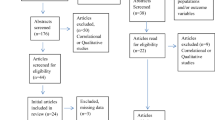Abstract
The purpose of this study was to examine the roles of age and gender in the symptom expression of separation anxiety disorder. Forty-five males and females of varying ages served as subjects. The nine symptoms included in the DSM-III diagnostic criteria for separation anxiety disorder were used as dependent variables. No gender differences were found on any of the symptoms. However, interesting age differences were discovered for specific symptoms and for the total number of clinically significant symptoms.
Similar content being viewed by others
References
Estes HR, Haylett CH, Johnson AM (1956). Separation anxiety.American Journal of Orthopsychiatry, 10.682–695.
American Psychiatric Association:Diagnostic and Statistical Manual of Mental Disorders (Third edition). Washington, D.C.; Author, 1980.
Bowlby J:Attachment and loss—Vol. II—Separation Anxiety and anger New York: Basic Books, 1973.
Last CG, Francis G, Hersen M, et al (in press): Separation anxiety and school phobia: A comparison using DSM-III criteria.American Journal of Psychiatry.
Ollendick TH, Mayer JA (1985). School phobia. In SM Turner (Ed),Behavioral treatment of anxiety disorders New York: Plenum Publishing.
Last CG, Hersen M, Kazdin AE, et al.: Comparison of DSM-III separation anxiety and overanxious disorders: Demographic characteristics and patterns of comorbidity. Unpublished manuscript.
Jersild AT, Holmes FB (1935) Children's fears. Child Development (Monoraph 20). New York: Teachers' College, Columbia University.
Miller LC, Barrett CL, Hampe E (1974). Phobias of childhood in a prescientific era. In A Davids (Ed),Child personality and psychopathology: current topics (Vol. I). New York: Wiley.
Ollendick TH. (1983). Reliability and validity of the revised Fear Survey Schedule for Children (FSSC-R). Behavior Research and Therapy,21. 685–692.
Gittelman R. (1986). Childhood anxiety disorders: correlates and outcomes. In R Gittelman (Ed),Anxiety disorders of childhood. New York: Guilford Press.
Kovacs M. The interview schedule for children (ISC): Form C and the follow-up form. Unpublished manuscript, 1978.
Kovacs M: The interview schedule for children (ISC): Form C and the follow-up form. Unpublished manuscript, 1983.
Author information
Authors and Affiliations
Additional information
This research was supported in part by NIMH Grant MH-00546.
Rights and permissions
About this article
Cite this article
Francis, G., Last, C.G. & Strauss, C.C. Expression of separation anxiety disorder: The roles of age and gender. Child Psych Hum Dev 18, 82–89 (1987). https://doi.org/10.1007/BF00709952
Received:
Revised:
Accepted:
Issue Date:
DOI: https://doi.org/10.1007/BF00709952




